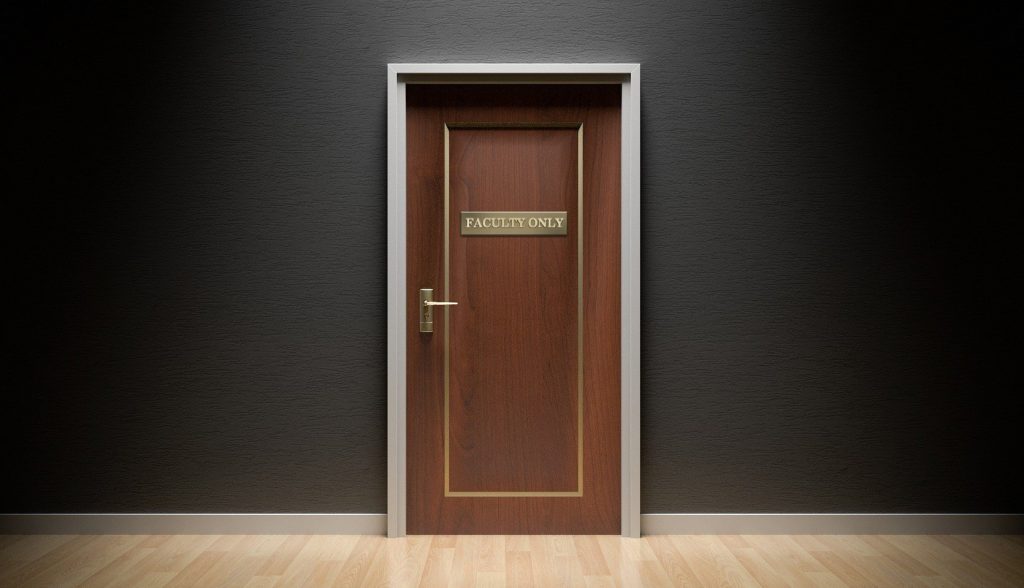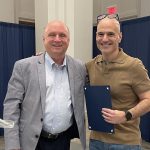“Colleges Are Deeply Unequal Workplaces,” reads the title of Jeffrey Selingo’s August 1 essay in the Atlantic Monthly. Examining how the pandemic has affected university and college employees in the United States, Selingo points out that staff on many campuses have been hit hard with layoffs and furloughs, whereas full-time faculty have been treated with consideration and flexibility.
Similarly, Lee Skallerup Bessette demonstrates in “Same Covid Stress, Different Benefits” and “The Staff Are Not OK” that faculty and staff have faced comparable pandemic challenges yet have received markedly different treatment from their employers. Faculty, she reports, have been given special consideration, praise, and time off. Staff, by contrast, have endured extra duties and simultaneous questions about their diligence, accompanied by a few extra vacation days (at best) or furloughs (at worst).
Privileging faculty over staff appears to be fundamental to US academic culture.
At the University of Notre Dame, for example, faculty searches quickly resumed while a prolonged staff hiring freeze forced many individuals to absorb additional responsibilities—for some, the equivalent of two full-time positions. A new winter term over the extended break meant more work for faculty (who volunteered) and staff (who had no choice) but supplementary income for the former only. Faculty can now apply to a recovery program for grants and course releases to offset the pandemic’s impact on their teaching and research. Staff have yet to see anything remotely commensurate.
Across the country, staff have been an afterthought in pandemic planning despite shouldering much of the responsibility in the execution. “These inequities,” Bessette explains, “send a clear message from their employer and institution that [staff] matter less than professors.”
But this message is not new. As Scott Appleby asserts in Dignity & Development’s inaugural blog post, the pandemic has exacerbated inequities that have long existed. The privileging of faculty over staff appears to be fundamental to US academic culture. It is a common observation among campus employees that universities and colleges function like stratified class systems. Before the pandemic, however, the communication and reinforcement of these hierarchies tended to be less blatant, typically taking the form of innumerable oversights, subtle gestures, and insensitive jokes.
A special brand of aggression
Microaggressions (with “micro” referring to the aggressions’ commonality not their enormity) are everyday slights or insults that communicate bias. According to Sue et al., microaggressions can be verbal, behavioral, or environmental; intentional or unintentional; and explicit or implicit. They range from overt discrimination to comments and behaviors that serve to either undermine, insult, or demean a target or exclude, negate, or dismiss a target’s thoughts, feelings, or experiential reality. Building off Sue et al.’s work on racial microaggressions, Young et al. coined the term “hierarchical microaggressions” after discovering that 42 percent of the everyday slights that their university employees reported during cultural competence workshops pertained exclusively to a target’s institutional role.
University and college employees throughout the United States, myself included, have witnessed staff treated as no more than faceless service providers and have been berated, on occasion, when they did not immediately respond to a last-minute or after-hours request. Despite being integral to institutional functioning, staff may find their expertise questioned or ignored, and they may be left out of email communications, meetings, or decisions directly related to their positions. Young et al. summarize: “Each microaggressive action sends a new message to the employees—you do not belong, you are not like us, and staff are not smart people. In an environment based on belonging and smartness, these messages impact employees professionally and personally.”
Hierarchical microaggressions are not exclusive to higher education and exist in many other contexts; they are, however, particularly notable given the pervasive rhetoric on campuses about equality (Young et al.). US universities and colleges bill themselves as sites of upward mobility. Undergraduate and graduate students can take courses about privilege and structural injustices. Professors advise practitioners, policy makers, and world leaders about social reform. Yet rather than eliminate microaggressions, academia has a blind spot to their occurrence in faculty-staff relations.
Paula M. Krebs suggests in “The Faculty-Staff Divide” that academic culture may even foster a mindset that can result in faculty viewing staff “the way upper-class Victorians thought of their servants.” Krebs, a tenured professor and the Modern Language Association’s executive director, describes her privilege: “we acquire instant status inside a culture that encourages us to see ourselves as thinkers rather than as workers. . . . We are encouraged to see the workers around us as there to make our jobs easier, rather than as fellow employees.”
Microaggressions—hierarchical or otherwise—do not exist in a vacuum. They are legitimized and perpetuated by long-standing attitudes, structures, and policies. As Bessette establishes in her Chronicle of Higher Education series, which also includes a piece on microaggressions against staff, significant discrepancies exist between faculty and staff when it comes to campus governance, salary distribution, and promotion structures. In addition, universities and colleges place role-based restrictions on leadership and supervisory positions. Faculty, for example, routinely supervise staff whereas staff are typically prohibited from supervising faculty. All of this, from the everyday insults to the institutional policies, serves an overarching, if unspoken, operative assumption that some employees are superior to others.
Intersectionality and academia
Before layoffs and hiring freezes, higher education’s regular and systematic (de)valuing of certain institutional roles created a toxic culture that takes a regular and devastating toll on its employees’ well-being. Furthermore, the implicit undertones of academia’s allegiance to hierarchy juxtaposed against its explicit pledge to equality make each slight sting a bit more and feel all the more insidious. These constant indignities hurt on a personal level; but they also hurt us as a culture, within and beyond our campuses.
Institutional status hierarchies undermine higher education’s credibility and contribute to the larger social issues of ignoring labor and mistreating unseen workers. They impede other important diversity initiatives like the fight against racial and gender inequality. Beyond creating divides between potential allies, bias breeds bias. If you are willing to devalue someone based on the work that they do, you are willing to devalue them based on other identity markers. In addition, intersectionality teaches us that all the aspects that constitute our identity combine to create different, and frequently compounding, experiences of privilege and discrimination.
If academic institutions want their diversity efforts to be more than noise, we must consider workforce inequities as part of the problem.
Teaching and research are central to universities and colleges, but significant additional labor is needed to deliver a quality education. Many intelligent, talented, hard working people care about student development and knowledge creation, but they chose not to get a PhD and/or did not want to be teachers and researchers. Instead, they contribute in other valid and important ways—as advisors, rectors, technicians, communicators, maintenance personnel, coordinators, developers, building managers. Universities and colleges would not and could not exist without these individuals.
Dignity for all campus employees
The Keough School of Global Affairs’ definition of integral human development makes it clear that work is essential to how humans define themselves. Work may be mutable, at least to some degree, in a way that a person’s skin color, cultural heritage, and sexual orientation are not. But that does not make work any less important to a person’s identity, and it does not make work a permissible category for discrimination. As Dignity & Development’s editor Clemens Sedmak states, “There are no hierarchies when it comes to human dignity.”
If academic institutions want their diversity efforts to be more than noise, we must consider workforce inequities as part of the problem. We are going to have to examine all the biases within ourselves and on our campuses. We are going to have to wrestle with how our various privileges come at the cost of someone else’s, and we are going to have to face our natural hesitancy to change what grants us an advantage. And, if we find ourselves in a position of power or privilege, we are going to have to say and do something—and keep saying and doing things—to change the unfair beliefs and structures that adversely affect our fellow employees, our fellow human beings.
Denise A. Ayo is the associate director of undergraduate programs in the Keough School of Global Affairs at the University of Notre Dame. She holds a PhD in English from Notre Dame and is pursuing a MS Ed degree in clinical mental health counseling from Indiana University South Bend.
This article is part of a series of blog posts published by the Keough School of Global Affairs. Dignity and Development provides in-depth analysis of global challenges through the lens of integral human development.



